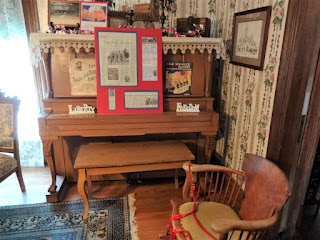
Inside the house there's a collection of items from workers, gun owners, revolutionaries, widows, orphans, musical instruments and lasting architectural design. Visitors can browse through antique books, old photos, vintage clothing, parlor-style furniture, and the remnants of lives well-lived.
Decorated in period-correct wallpaper, the interior is warmed by a shared fireplace in the wall between the parlor and the sitting room.
"Mid-nineteenth-century homes included a formal parlor, sometimes described by social historians as a sacred space, where weddings, funerals, and other public events were held."
At times, it might hold the body of the deceased on display for visitation by friends and relatives prior to the funeral. The parlor was likely the most expensively furnished and elegant room in the entire house.
"The parlor furniture was made of richer materials and included the piano for entertaining guests. The cozier sitting room was used by the family for reading and sewing."2
A ceramic and enamel container held excess ashes from the hearth. As the fire was the primary source of heat, it would need to be emptied on a regular basis.
"A family would gather in the sitting room in the evening, drawing close together to share the light of an oil or kerosene lamp.
Reading was a popular activity during which the family was likely to listen to someone reading aloud. Typically, the man of the house would read aloud, while women engaged in some form of sewing or handwork."
A writing desk and a comfortable chair were highly valued items in a sitting room.
Anna Hicks Bain, born in 1834, was eleven years younger than her husband, John Alexander Bain, who passed away in November 1862. A widow at twenty-eight years old, she raised five daughters in the house following his death. She smartly supplemented her income by dividing the 6.7 acres into smaller plots which became commercial properties and by taking in boarders in the spare rooms upstairs.
This room offered entry to the house through the back doors, possibly used as the servant's entrance, or to allow boarders a private access to the stairs. It served as a mud room in inclement weather to store wet boots and outer garments or in summer as a place to cool off. Off the screened porch is a brick path leading to the outhouse and the fresh-water well.
The porch allowed access to the informal dining area, possibly an eat-in kitchen where food was prepared. Cold food was stored in the wooden ice box in the corner. A sign would be put in the window to let the ice man know what size block to bring in from his truck.
Many of the daily chores revolved around cooking, baking, cleaning, washing, mending, raising chickens, planting a garden, gathering the harvest. In the absence of modern appliances, most work was done by hand. Sundays were a day of rest and worship.
When the Bain-Honaker house was built in 1865, it was a time of national unrest with the war between the states just winding down. Supplies were scarce, tensions were high and many wounded men were returning home after battling neighbors and brothers over issues of States' Rights versus Federal Authority, Westward expansion and slavery. The years 1860 - 1864 marked some of our nation's most difficult times, certainly a difficult time to lose a husband and raise five children alone.
Music played a large role in daily life in the absence of telephones, television or radio. Books and reading, singing, sewing and hand crafts kept idle hands busy.
Anna Bain's daughters, Mary and Catherine (Cassia) married brothers Henry Honaker and Andrew Honaker. Cassia lived in the house until her death in 1928. Five generations lived in the house.3
The bathroom was upgraded over the years. There's an upstairs bathroom with the old cast iron bathtub and another remodeled bathroom downstairs.
The house was donated to the Farmersville Historical Society by a descendant in 1989.
Farmersville, Texas is the place to visit if you enjoy quaint, old-fashioned towns with antiques and curiosities. Located near Highway 380 and Highway 78, the town has friendly merchants, good food, a quiet laid-back environment and the largest yarn store in Texas.
Sources:
- John Alexander Bain, March 15, 1823 - November 1862. Facts from Ancestry dot com
- Anna Hicks Bain, 1834 - 1906
- Collin County Texas dot Gov, Bain Honaker House







No comments:
Post a Comment